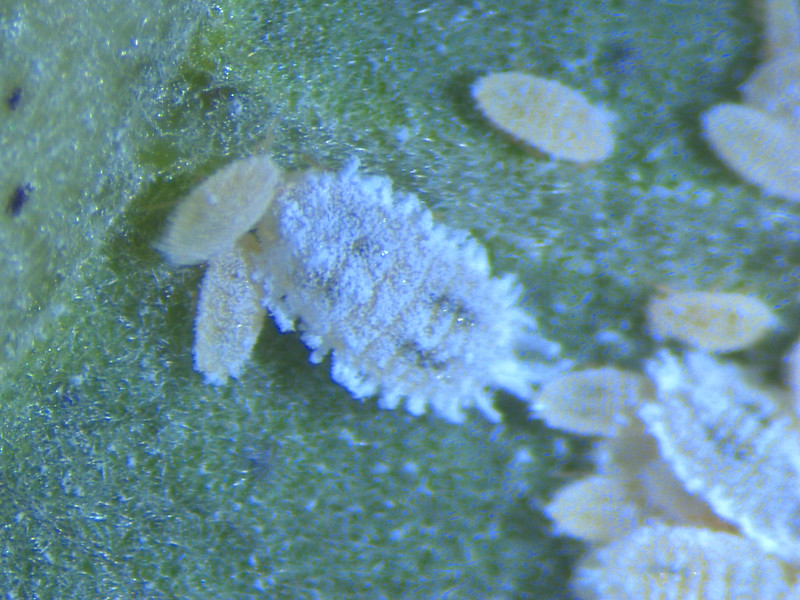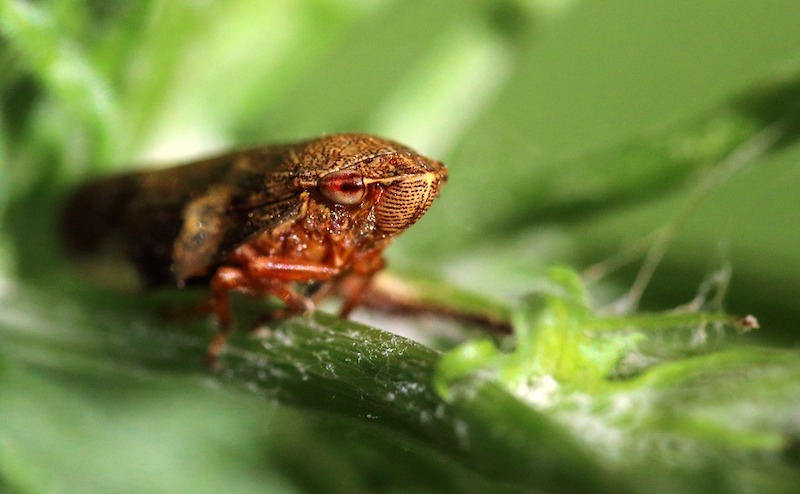Foxglove, Digitalis spp, are generally easy to grow and are rarely bothered by pests or diseases. The European native plant Digitalis Purpurea was introduced to the United States in the 1700s and has since become a beloved if not essential plant in any cottage garden or cut-flower garden plan. Pests that attack Foxglove tend to be sap-suckers, gastropods, and beetles. Recognizing the different symptoms and damage that each pest causes is essential in correcting and reducing outbreaks.
Common Foxglove Pests
Aphids
Aphids come in many colors and tend to be host specific to a wide variety of ornamental and edible plants. Foxgloves often attract green aphids, about ⅛” long, which feed on the sap and nutrients of lush new foliage in the spring. The pear-shaped nymphs and adults are usually found on the undersides of leaves or inside curled and twisted foliage that has already been drained of its nutrients. In small numbers, the damage is not usually harmful or even noticeable but left to reproduce, large numbers of aphids can cause leaf distortion, eventually weakening the plant so much that it dies.
Treating Aphids on Foxglove
Aphids rarely cause extensive damage on Foxglove and are easily washed off the plant with a strong blast of water from the hose. The water both drowns the insects and removes them from the plant. Repeat this treatment once every 2-3 days until no more aphids are seen. Large infestations of aphids may require the use of an insecticidal soap spray. Look for sustainable brands that have the OMRI certification on their labels. This ensures a safer product that is rated as compatible with home and commercial organic growing methods. Encouraging beneficial predators such as lady beetles, lacewings, and syrphid flies to make their home in your garden is the best way to keep aphids in check. Aphid outbreaks may still occur, but with beneficial predators ready to feast on the eggs or nymph stage, these pests will only do mild damage.
Preventing Aphids on Foxglove
Aphids appear in late spring as new growth takes off. Overuse of nitrogen-rich fertilizers often results in quick, dense foliage growth that is weak because the root system is not prepared to support extra top growth. If Foxglove is growing in a shady location, the plant will be weakened even more as it struggles to reach for more sunlight. Weakened plants are easy prey for aphids. Always plant Foxglove in a location with at least 6 hours of part sun exposure and well-draining, moderately rich soil. Lightly fertilize garden-grown Foxglove only once in early summer as they prepare to send up flower spikes, or mulch annually with organic compost.
Mealybugs
Although mealbugs, Pseudococcus affinis, are often thought of as an indoor pest, gardeners in mild climates, USDA growing zones 9-11, may be plagued by mealybugs on their outdoor ornamental plants. These are sap-sucking insects with an oval shape and flat profile. A layer of waxy residue protects them from predators and parasites. The waxy layer can also make them look like scale insects at first glance. The insects will be found in protected locations on the plant such as the undersides of leaves, at the base of flower buds on the stem, or in the crown. Secondary infections of sooty mold and ant infestations may result from mealybugs that are left untreated.

Photo by Scot Nelson
Treating Mealybugs on Foxglove
Mealybugs are not easily treated with chemical controls due to the waxy coating that protects their soft bodies. Small colonies that are treated quickly will rarely do much lasting damage to Foxglove and are better treated with mechanical means. Mealybugs can be washed off plants with a strong jet of water or rubbed off with your fingers. (Gloves are optional for this task.) Deciding not to spray broad-spectrum pesticides on your garden allows beneficial predators to thrive. Lady beetles, lacewings, spiders, and minute pirate bugs all feast on mealybugs and will keep their populations to a minimum. Remove any plant material that is severely damaged, so that other pests and diseases do not take advantage of the plants’ weakened state.
Preventing Mealybugs on Foxglove
Do not grow Foxglove in locations where mealybugs have been a problem in the past. This is much more important in warmer climates that do not have freezing winter temperatures to fully kill off populations of pests. Inspect all plants and tools that are brought into the garden. Any weak or sick plants may need to be quarantined or removed altogether if the infestation is too great to treat. Cut out affected foliage or flower spikes to remove any eggs that may have been laid. Always dispose of the infected plant material in the trash or by burning it. The home garden compost is rarely hot enough to completely eradicate insect pests.
Gastropods
Gastropods include the common garden snail and slugs of all types. Although most people think of slugs and snails as being destructive pests of garden plants, they are also the most productive decomposers in the garden. Without the aid of gastropods, plant material would take much longer to fully break down. These garden decomposers do not discriminate between actively growing plants and garden waste, and in some climates, they can become the thorn in a gardener's side. Foxglove seedlings are often the target for overnight slug and snail destruction. In the early morning hours, telltale trails of slime will be seen near and on the foliage of eaten plants. The edges of large leaves may be ragged and eaten away, while small enough seedlings may just seem to vanish overnight. During the daytime hours, gastropods typically return to protected parts of the garden such as nooks and crannies in rock walls or under foliage and debris on the garden floor.

Photo by portengaround, unedited, Flickr, Copyright CC BY-SA 2.0
Treating Gastropods on Foxglove
The number of gastropods in the garden can be controlled using traps and low-risk pellet bait formulated with iron phosphate such as Sluggo. Iron phosphate is not dangerous to any mammals or birds and decomposes in the garden, acting as a fertilizer. Sluggo will need to be reapplied after periods of heavy rains. Placing shallow tuna cans filled with beer or another liquid also can control slug and snail levels in the garden. Place the traps near the plants you want to protect. The slugs and snails will fall in and not be able to get back out. Make sure to empty and refill the traps every morning. Encouraging wildlife into your garden will also help to control gastropods. Salamanders, garter snakes, toads, and a wide variety of ground-foraging birds are natural predators.
Preventing Gastropods on Foxglove
Preventing gastropods may be difficult in some climates, especially areas that have high rainfall or moderate temperatures that do not freeze and kill the eggs in the winter. Preventing damage to seedlings and young plants is as easy as timing your transplanting. Plant new Foxgloves in the garden when they are large enough to fend off damage from an overnight slug attack. Broad-spectrum pesticides can damage the beneficial predators and pollinators in the garden. Only use a chemical spray when absolutely necessary and according to the manufacturers' directions. Choose sustainable pesticides that are certified by OMRI, Organic Materials Research Institute.
Spittlebug
Spittlebugs are sometimes called Froghoppers, and while they have wings, they rarely fly from plant to plant. In the spring, the telltale froth of white foamy spit may be evident on stems and in the leaf joints of Foxglove plants. This foam is a protective layer for the nymphs who are busy feeding and transforming into adults by early summer. Even though the spittle cocoons look strange and slightly sinister, spittlebugs rarely do any real damage to their host plant. Foxgloves will tolerate small infestations with no adverse results. By the time the hot weather of midsummer arrives, a new generation of adult spittlebugs will emerge from their frothy coverings.
Identifying Spittlebug on Foxgloves
Spittlebugs lay eggs on the stems, at the tips, or in the joints of leaves. A mass of foamy liquid protects the nymphs against predators. No other damage may be apparent until after the adults emerge. Most often the only true damage to a plant is the loss of some leaves or smaller stems.

Treating Spittlebug on Foxglove
Spittlebugs can be left on a plant without risking the health of your plant. If the spittle cocoons are just too much to look at, they are easily washed off the plant with a sharp blast of water from the hose.
Foxglove Pests Chart
|
Pest |
Identifying |
Treating |
|
Aphids |
Pear-shaped bodies with long antennae, often green, about ⅛” long |
Wash off the plant with a strong blast of water from the hose |
|
Mealybugs |
Sap-sucking insects with an oval shape and flat profile |
Wash off plants with a strong jet of water or rubbed off with your fingers |
|
Gastropods |
Common garden snail and slugs of all types |
Use traps and low-risk pellet bait formulated with iron phosphate such as Sluggo |
|
Spittlebug |
Small, often green or brown, insects with broad, creates frothy masses (resembling spittle) |
Wash off plant with a sharp blast of water on affected areas |
Sources:
"Digitalis purpurea." The North Carolina Extension Gardener Plant Toolbox. plants.ces.ncsu.edu
"Foxglove (Digitalis)." Connecticut State - The Connecticut Agricultural Experiment Station. portal.ct.gov
 |
Author Robbin Small - Published 6-28-2023 |
